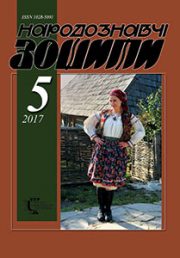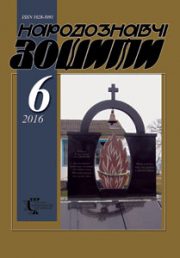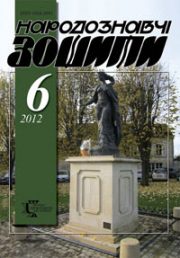The Ethnology Notebooks. 2019, № 3 (147), 608—621
UDK 392 : 638.1 ] (= 161.2) (438.24)
DOI https://doi.org/10.15407/nz2019.03.608
THE RITUAL COMPLEX OF TRADITIONAL BEEKEEPING OF UKRAINIANS OF NADSIANNIA
MOVNA Ulyana
ORCID ID: http://orcid.org/0000-0002-9763-2455
Doctor of Sciences of History, Senior Researcher
of the Institute of Ethnology of the National Academy
of Sciences of Ukraine,
in the Department of Historical Ethnology,
15, Svobody Avenue, 79000, Lviv, Ukraine
Contacts: е-mail: movlana@ukr.net
Abstract. Rituals, as one of the structural elements of the ethnic culture, which is a complex, integral, interrelated, historically conditioned system of the whole array of the human experience are among prevailing on the scale of multilevel components of the worldview complex of the Ukrainians. Within this aspect, apiarian rituals are no exception, expressively manifested at all stages of the annual beekeeping cycle. They would make an organic part of the integral system of religious beliefs of the Ukrainians. Therefore, studying local specifics of the ritual complex of separate ethnographic areas presents sufficient scientific rationale and is topical.
The object of the research is the traditional apiculture as an inherent component of the Ukrainians’ ethnoculture, and the subject matter is its ritual complex accumulating apiarists’ ritual practices, notions, beliefs, customs and rites. The ritual complex of the traditional apiculture of the Ukrainians from Nadsiannia has never been a subject of a special research; therefore the main source basis for the exploration is the author’s field data.
Basic parameters of spiritual and worldview apiculture paradigm, particularly the folk vision of a bee, including the status of the insect in the folk tradition, its place in the system of traditional ritualism, especially the general portrait of a apiarist against the background of the past, narrative and conceptual accentuation and complete understanding of apiarian motives of folk calendar (ritual activities of calendar cycles), the role of apicultural products in the ritual life (calendar ritualism, rituals of human life cycle, magic ritual practice) were explored extensively and closely in a widespread semantic and problematic contexts. All of them are related to three basic concepts: high breed of bees, wealth of honey, safety and health of insects, and, thus, they are implemented mainly in three major semantic aspects — producing and apotropaion actions.
The main products of bees’ life activity — honey and wax — firmly «grew» into a live tissue of calendar and family customs as the universal polysemantic ritual symbols. It has been found that folk visions were influenced by mythological connotations of wax as one of «first creations». The symbolatry of wax candle has its origins in the ancient cult of fire with its ambivalent nature — respect and fear with worship for fire as a God, and later — as a symbol of the Divine power, sign of light, light-bearing source, capable of overcoming the dark forces of the evil.
The comparative ethnological analysis of apiarian ritualism of the Ukrainians of Nadsiannia has found both local feature of separate visions and beliefs, all-Ukrainian worldview matrix of apiarian spiritual phenomenon.
Keywords: beekeeping, ritual complex, Nadsiannia, Ukrainians, bee, apiarist.
Received 16.03.2019
REFERENCES
Movna, U. (2017). Beekeeping: Ukrainian ritual context. Lviv [in Ukrainian].
Movna, U. The field materials of the traditional beekeeping, written on Javoriv Region (2007, 30 May — 9 June). In The Archive of IN NANU. F. 1. Оp. 2. Spr. 559 [in Ukrainian].
Kylymnyk, S. (1994). Ukrainian year in folk customs in historical light: in 3 b., 6 v. (Book 2, vol. 3). Kyiv: Oberegy [in Ukrainian].
Wrublevski, R. (1997). Beliefs and customs of Polish beekeepers. Novy Sacz [in Polish].
Civian, T.V. (1993). Protecting against evil eye: example in Albania tradition. In Researches in field of Baltic and Slavoniс Spiritual Culture: incantation (pp. 164—169). Моscow: Science [in Russian].
Frankovski, E. (1925). Magic means in loan, buying and sale in Polish people. Lviv [in Polish].
Makovey, O. (1895). Holiday customs, rituals and beliefs in Javoriv. Pravda (Vol. 24, pp. 50—55) [in Ukrainian].
Bajburin, A.K. (1993). Ritual in traditional culture. The structural-semantically analysis of Eastern Slavonic rituals. SPB.: Science [in Russian].
Bajburin, A.K. (1983). Housing in rituals and notions of Eastern Slavic. Leningrad: Science [in Russian].
Kostyk, O. (2003). Torky. The village on San. Peremyshl [in Ukrainian].
Lozovsky, M. (1988). The village Lazy. Collection of historical, archeological, ethnographical drawing and memories about Ukrainian village Lazy in Western Ukraine. Тоronto; New York; Paris; Sidney [in Ukrainian].
Bereza, J. (1939). The Christmas notes (іn Vorochev-Polanki, Horodok Region). Zhytia i Znania, 1, 2—4 [in Ukrainian].
Kylymnyk, S. (1994). Ukrainian year in folk customs in historical light: in 3 b., 6 v. (Book 1). Kyiv: Oberegy [in Ukrainian].
Koval-Fuchylo, I. (2003). On problem: sin and penalty in Ukrainian folk tradition (on materials from folklore texts, written in village Mali Mokryany Mostyska Region Lviv Province. Dialectological studies, 2, 201—222 [in Ukrainian].
Chomchak, L. (2009). Materials to ethnolingvistical vocabulary of family ritualism of Nadsiannia: birth ritual. Dialectological studies, 8, 199—237 [in Ukrainian].
Nudga, G. (1976). «De Russorum, Moscovitarum et Tartarorum»… Zhovten, 10, 145—152 [in Ukrainian].
Laguna, S. Folk rituals. Folk medicine. Illness of animals. Fortune tellers. In VR LNNBU im. V. Stefanyka. F. 5. Op. 1. Spr. 4435.
Lozinski, J. (1992). Ukrainian wedding. Kyiv: Scientific Opinion [in Ukrainian].
Bereza, J. (1933). The Funeral customs on Lviv environs. Zhytia i Znania, 11, 307—308 [in Ukrainian].
Mucaynovych, A. (1912). The Funeral customs and rituals in village Vighomlia Javoriv Region. Ethnographical collection (Vol. 31/32, pp. 379—384). Lviv [in Ukrainian].
Kolberg, O. (1891). Przemyskie. Ethnographic picture. Krakow [in Polish].
Toporov, V. (1993). About Indo-European incantation tradition (selected chapters). In Researches in field of Baltic and Slavoniс Spiritual Culture: incantation (pp. 3—106). Моscow: Science [in Russian].
Petrov, V. (1963). The incantations. In With history of Russian Folkloristic (pp. 77—142). Leningrad: Science [in Russian].
Usachova, V.V. (1994). The vocative formulas of folk medicine in Slavic. Slavonic and Balcan folklore. Beliefs. Text. Ritual (pp. 222—240). Моscow: Science [in Russian].







